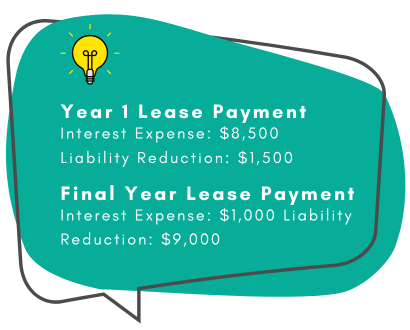Most businesses require expensive equipment to function. The cost of this equipment leads many firms to lease instead of buy, and two major types of long-term lease exist. To make sound business decisions, it’s critical to grasp the relative merits of finance leases vs operating leases. We’ll explain both in the below article.
Lease Terminology
We first need to introduce some basic terminology. Accounting Standards Codification (ASC) 842 defines a lease as: “a contract […] that conveys the right to control the use of […] an identified asset for a period of time in exchange for consideration [i.e. something of value].” That is, a lessor receives value (e.g. money) in exchange for allowing a lessee to use an asset.
Businesses considering leasing assets must understand that finance and operating leases require different accounting treatment.
What Are Finance Leases?
A finance lease is a long-term lease of a fixed asset where the lessee assumes most risks and rewards of ownership. However, with these agreements, actual ownership of the leased asset remains with the lessor.
For example, a manufacturing business might enter into a finance lease for assembly-line machinery. The lease would normally cover the machinery’s useful life and include a likely-executed purchase option at the end of the term. In this scenario, the manufacturing business de facto owns the equipment during the lease term, with formal ownership typically transferring to the lessee at the end of the term.
From an accounting perspective, finance leases function more like purchase-and-sale agreements than traditional leases. The rights and risks of owning the leased property transfer from the lessor to the lessee. Business owners substantively purchase the asset, but accounting standards treat these transactions as leases.
What Are Operating Leases?
An operating lease is also a long-term lease agreement for a fixed asset, but the lessor retains effective ownership and associated responsibilities. In this way, operating leases share more similarities to rental agreements than finance leases.
For example, a plumbing business may sign a three-year lease for a utility van from a car rental company. As an operating lease, the plumbing business makes regular lease payments while the rental company retains vehicle ownership and, typically, maintenance responsibilities. At the conclusion of the lease term, the plumbing business would return the utility van to the rental company.
The accounting for an operating lease mimics a rental agreement. For the lease term, business owners record lease expenses in the amount of their regular payments to the lessor.
Factors Determining Lease Classification
Accounting standards include five criteria for determining whether a lease qualifies as finance or operating. If the lease agreement includes any of the following characteristics, businesses account for it as a finance lease. Conversely, if the terms do not meet any of these criteria, it qualifies as an operating lease. In other words, if business owners answer “yes” to any of the below questions, they must record the lease as a finance one for accounting purposes:
Specialized lease: Is the leased equipment so specialized that the lessor has no realistic alternative use for it at the end of the term?
Purchase option: Does the lease agreement include a purchase option the lessee is reasonably likely to execute?
Title transfer: Does title (i.e. ownership) of the asset transfer from the lessor to the lessee at the conclusion of the lease term?
Economic life: Does the lease term include the major portion of the asset’s remaining economic life (>75%)?
Fair value: Does the present value of all lease payments comprise the vast majority (>90%) of the asset’s fair value?
Financial Reporting Differences: Balance Sheet and Income Statement
For financial reporting purposes, there is no initial difference between operating and finance leases. That is, both record a right of use (ROU) asset and lease liability on the balance sheet. Businesses record both of these amounts at the present value of the total lease payments. However, reporting differences arise in the subsequent entries.
Recall, an operating lease functions more like a traditional rental than an equipment purchase. As a result, businesses only record a single expense on the income statement, lease expense. This expense equals the cash amount of that lease payment. Concurrently, each lease payment includes an equivalent reduction in the total lease liability and ROU asset. At the conclusion of the lease term, both the lease liability and ROU asset balance sheet accounts reach zero.
Due to functioning more like a sale than a true rental, finance lease payments include two expenses on the income statement. The amortization expense functions roughly as depreciation expense for traditionally owned assets. That is, with each lease payment, an amortization expense reduces the balance on the ROU asset, effectively allowing businesses to claim depreciation on a leased asset.
Concurrently, finance leases include an interest expense. Similar to an amortizing loan, a portion of each finance lease payment goes towards interest, and the remainder pays down the balance of the lease liability on the balance sheet. As with loans, early year payments go more towards interest, while later year payments go more towards curtailing the lease liability. At the end of the lease, as with operating leases, the ROU asset and lease liability balance sheet accounts are brought to zero.
Journal Entries for Operating and Finance Leases
To provide amplifying information on the the financial reporting differences between finance and operating leases, we’ve included the initial and subsequent journal entries for both types here:
Operating Lease Initial Entry
| Account | Debit (Dr) | Credit (Cr) |
|---|---|---|
| Right of Use (ROU) Asset | $X,XXX | |
| Lease Liability | $X,XXX |
Operating Lease Subsequent Entries
| Account | Debit (Dr) | Credit (Cr) |
|---|---|---|
| Lease Expense | $X,XXX | |
| Lease Liability | $X,XXX | |
| Right of Use (ROU) Asset | $X,XXX | |
| Cash (i.e. lease payment) | $X,XXX |
Finance Lease Initial Entry
| Account | Debit (Dr) | Credit (Cr) |
|---|---|---|
| Right of Use (ROU) Asset | $X,XXX | |
| Lease Liability | $X,XXX |
Finance Lease Subsequent Entries
| Account | Debit (Dr) | Credit (Cr) |
|---|---|---|
| Interest Expense | $X,XXX | |
| Lease Liability | $X,XXX | |
| Amortization Expense | $X,XXX | |
| Right of Use (ROU) Asset | $X,XXX | |
| Cash (i.e. lease payment) | $X,XXX |
Finance Lease Amortization Schedules Explained
For finance leases, the lease liability amortizes similarly to a typical mortgage loan. Accountants apply a portion of each cash lease payment to interest expense, and the remainder pays down the outstanding lease liability balance.
To calculate the interest expense portion for a specific payment, multiply the outstanding lease liability balance by the interest rate and time period. Then, subtract that amount from the lease payment to determine the portion applied to paying down the lease liability. In this fashion, interest expense exceeds liability curtailment early in the lease term, and liability curtailment exceeds interest later in the term.
For example, assume an annual lease payment of $10,000. In Year 1, say you calculate interest expense of $8,500. That would mean $1,500 of the Year 1 lease payment ($10,000 payment minus $8,500 interest expense) pays down the total lease liability. Now, assume in the final year of the lease, the interest expense equals $1,000, which makes sense due to the smaller outstanding lease liability balance. In this payment, $9,000 of the $10,000 payment would go towards paying down the lease liability.

Tax Implications: Finance vs Operating Lease
For tax purposes, finance leases allow lessees to claim both amortization (i.e. depreciation for leases) and interest expenses. Conversely, operating leases allow lessees to claim the entire lease payment as an expense. Depending on a business’s circumstances, either of these tax scenarios could make more sense.
Generally speaking, finance leases provide greater long-term tax benefits, but operating leases provide more accounting simplicity and business flexibility.
Which Lease Type is Better?
We’ve now answered two key questions: 1) what is an operating lease?, and 2) what is a finance lease? Lastly, we need to ask, which type is better? It depends.
If seeking the tax and business benefits of owning an asset, a finance lease may make more sense. For instance, a manufacturing company that relies on specialized equipment to produce goods would likely want to effectively own that equipment. Without the leased equipment, the business couldn’t operate. The control and depreciation-like benefits of a finance lease offer that effective ownership to a business.
On the other hand, operating leases provide lower upfront costs, greater business flexibility, and simplified bookkeeping procedures while still offering the tax benefits of deductible lease payments. For example, a business requiring a fleet of vehicles would likely prefer operating leases. These lease structures allow the business to quickly lease vehicles while avoiding larger upfront costs, maintenance responsibilities, and the accounting complexity of finance leases. Plus, vehicles are largely interchangeable, non-specialized assets, meaning a company has less need to lease a specific vehicle for an extended period of time.



